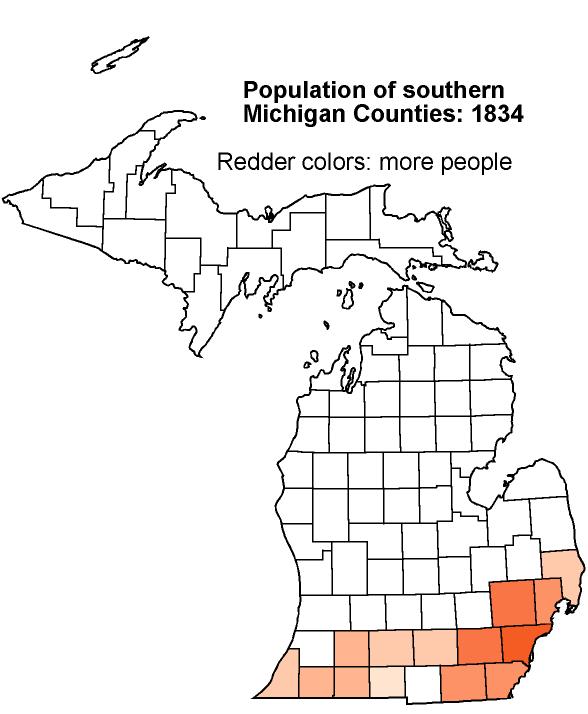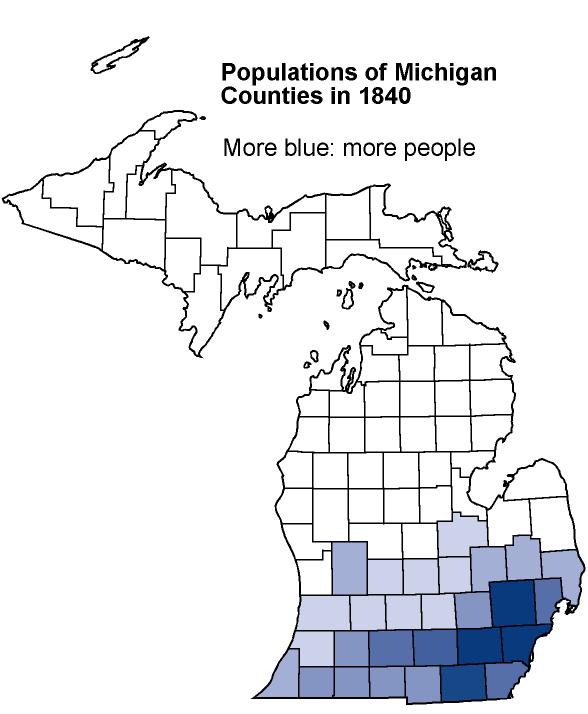EUROPEAN SETTLEMENT
There is relatively little written about Michigan as it pertains to the American frontier.
This may be due in part to the unique geographical nature of the state and its rather
unusual history. The standard frontier histories bring a rush of settlers into southern
Michigan after the Erie Canal was opened, and, after a few paragraphs most historians move
on westward, leaving the people who came to Michigan in early 1830's to build up the
state. The implication is that with this start, Michigan grew in population by the natural
increase of its first settlers and by immigration, and that the vacant places were thereby
filled up, producing the Michigan of today. It also is implied that Michigan was
influenced in its growth not only by the experiences of pioneers prior to the 1830's but
also by the frontier as it moved westward across the continent. Nothing of this sort
really happened.

Source: Michigan
State University, Department of Geography
The Michigan frontier of the 1830's was confined to only about 25 of the state's
present 83 counties. It did not reach much further north than the four southern tiers of
counties. North of a line drawn through Muskegon and Bay City, the pinelands begin, and
underneath the pines the soil is thin and sandy. Furthermore, the growing season is
markedly shorter. Hence, pioneers seeking new farms by-passed northern Michigan and moved
on into Wisconsin and Iowa. They neglected Michigan's Upper Peninsula for the same
reasons. One writer on the West states that by 1848, when a great tide of immigration from overseas began, "Michigan was
so well integrated that much of this influx was forced to jump over into Illinois, Iowa,
and Wisconsin." Just what he means by his statement that Michigan was
"well integrated" in 1848 is obscure. The census of 1850 shows that over 98 per
cent of the state's population at that date lived in the southern counties of the lower
peninsula comprising about one-quarter of the state's total area. Only 7,649 people were
counted in an area of the north approximating the size of the state of Indiana. There
obviously was abundant public land left in Michigan, but its quality was such that it
could not compete for settlers with the more fertile lands further west, where the climate
was less severe.

Source: Michigan
State University, Department of Geography
In the 1840's, Michigan had a mining frontier of enduring importance to the
state and the nation, a fact that goes unmentioned in most of the histories of the
American West, though they deal at length with the mining rushes in the Far West. Yet the copper taken from Michigan mines, and the iron
ore produced in Michigan and across the state border in Wisconsin and Minnesota have
been of far greater importance in the building of the nation than the gold and silver
which came from the mining bonanzas of California, Nevada, and Colorado. A report made in
1841 by Douglass Houghton, the state geologist, was followed by a rush of prospectors to
the Copper Country of Michigan's Upper Peninsula and the establishment of mining camps
which had many of the characteristics of those a few years later in California. The
discovery of nuggets of silver with the copper added to the excitement. In 1844, iron was
discovered in another part of the Upper Peninsula and soon that ore, too, was being mined.
Michigan led the nation in copper production from 1847 until 1887, and in the production
or iron, Michigan ranked first until 1900. Of major importance in making the vast
quantities or ore in Upper Michigan accessible was the construction of locks and a canal
at Sault Ste. Marie.
The mining
frontier added a new dimension to Michigan's population. The dominance of New England
stock, so marked in the settlement of the farmer's frontier of southern Michigan, was
notably absent in the mining country, although Boston dollars were heavily invested in the
copper mines. The newcomers included at first workmen from the lead mines of Illinois and
Missouri. Heavy reliance was placed, over the years, on foreign immigrants. The
contributions of skilled miners from Cornwall were of inestimable value. There was a large
influx of Finns. Many Irish, Germans, and -after 1890-Italians, and other southern Europeans
came.
The migration of loggers, sawyers, rivermen, and investors in timber
from Maine to Michigan, then to Wisconsin, Minnesota, and the Far West played a vital role
in the development of significant portions of the nation. One writer on the American
frontier states that Michigan had nine times as many varieties of trees as Great Britain,
but he fails to note that one of them was the white pine, the lumber from
which was highly regarded because of its beauty and the ease with which it could be
worked. In 1847, a shipment of white pine lumber from Saginaw reached Albany, New York
where it was compared favorably with lumber produced in Maine, which was then the standard
of high quality. Shortly afterward, investors began the process of acquiring tracts of
timber in Michigan, and the migration of workmen, with their skills and tools, got
underway.
From 1860 until 1910, the harvest and sawing of logs and the marketing
of lumber was the major non-agricultural industry of the state. Immense fortunes were
made. One of the major reasons for the later concentration of the automobile
industry in Michigan was the fact that Detroit had men whose large fortunes had been
made in lumbering and mining and who were willing to invest money in automobile plants.
The movement of population into Michigan in the half-century during which lumbering was
dominant brought in a number of new elements. Among the workmen, Canadians, Irish, and Scandinavians, especially Swedes,
were heavily represented. But the proportion of foreign-born was not nearly so great in
the lumber camps as in the mining regions. Natives outnumbered foreign-born in 1890 in two
important lumbering counties, Muskegon and Manistee, by almost two to one.
Pine lumber from Michigan, Wisconsin, and Minnesota made possible the
building of farmhomes and barns, and Chicago was re-built after the great fire of 1871
with Michigan and Wisconsin pine. But the passing of the lumberman left to Michigan itself
a legacy of problems. Homesteaders and those who obtained land from the railroads or the
state tried, but in most cases failed, to make a living on the sandy soil in the cut-over.
Railroads, which had built lines into northern lower Michigan with the inducement of land
grants, were left with little traffic. The end of large-scale lumbering in the Upper
Peninsula, coupled with the decline, first of copper and then of iron production, brought
severe economic problems to that area. The relatively poor soils and the short growing
season repelled farmers; the distance from major markets did not make the region inviting
to manufacturing industries. The recreation industry, patronized
by tourists, resorters, and vacationists, became the major element in the economy of
northern Michigan.
This material has been compiled for educational use only, and
may not be reproduced without permission. One copy may be printed for personal
use. Please contact Randall Schaetzl (soils@msu.edu)
for more information or permissions.